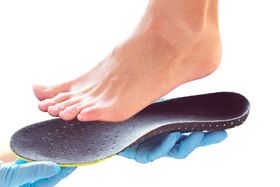Baxter’s Nerve Entrapment: Symptoms, Causes and Treatment
Updated December 19, 2024

As the name implies, Baxter’s nerve entrapment is the entrapment of the Baxter’s nerve, otherwise known as the inferior calcaneal nerve. This nerve runs from the inside of the heel through the foot arch to the outer heel. Generally, entrapment happens when there is a limitation in the movement of the ankle joint, flat feet, and pressure from a heel spur or plantar fasciitis.
When the nerve is entrapped, it causes symptoms similar to that of plantar fasciitis, which is why the two are often mistaken for each other. However, studies suggest that Baxter’s nerve entrapment may be responsible for as much as 20% of medial heel pain.
This article looks at the symptoms and causes of Baxter's nerve entrapment, how to distinguish it from plantar fasciitis, and some common treatment options.
Symptoms of Baxter’s Nerve Entrapment
Baxter’s nerve entrapment is often misdiagnosed because its symptoms are similar to plantar fasciitis symptoms. Apart from starting gradually without trauma or injury, both cause pain in the inner heel and affect all genders and ages.
However, Baxter’s nerve entrapment pain is more common on the heel and the medial aspect of the foot that is usually worse after a period of rest. When left untreated, it can result in numbness at the lateral part of the heel.
Causes of Baxter’s Nerve Entrapment
Baxter’s nerve entrapment is due to either compression, impingement, or entrapment of the inferior calcaneal nerve as it travels between the quadratus plantae and the abductor hallucis. Its possible causes include the following:
- Poor gait mechanics, like overpronation
- Compression from poorly fitting footwear
- Heel pad atrophy due to untreated heel spurs
- Repetitive strain to the nerve during trauma
Apart from these causes, several factors predispose individuals to Baxter’s nerve entrapment, including:
- Obesity
- Plantar fasciitis
- Heel spurs
- Flat feet
- Enlargement of lower limb muscles
How to Distinguish Baxter’s Nerve Entrapment From Plantar Fasciitis
As noted earlier, in Baxter’s nerve entrapment, doctors often make the mistake of diagnosing plantar fasciitis instead of Baxter’s nerve entrapment. To differentiate them, watch out for the location and type of pain experienced.
Pain due to plantar fasciitis is sharp and aching under the heel, while Baxter’s nerve entrapment causes sharp, burning pain and numbness at the inner heel. Baxter's nerve entrapment also causes tenderness on the inner heel and heightened pain after periods of rest.
Can You Treat Baxter’s Nerve Entrapment?
Thankfully, Baxter’s nerve entrapment can be treated if the diagnosis is made early enough. The primary goal of treatment at the initial stage is to remove any compression, which should naturally resolve any pain. At home, the first line of treatment you should follow when managing Baxter’s nerve entrapment includes the use of non-steroidal anti-inflammatory drugs (NSAIDs), rest, ice, and activity modification.
Other treatments include:
Proper Footwear
Using proper footwear can reduce the pressure on the heel and relieve the symptoms.
Stretching and Strengthening Exercises
Stretching and strengthening programs can place the foot in a better position to adapt to the demands placed on it by the activities.
Orthotics
Orthotics are ideal for managing the symptoms of Baxter's nerve entrapment and relieving any pressure causing nerve compression. When appropriate orthotics are used, they can also help improve foot mechanics. Understand that the wrong orthotic inserts can worsen the condition. For example, using orthotics meant for plantar fasciitis can increase the pressure on the heel and the compression of the inferior calcaneal nerve.
Consequently, custom orthotics designed by professionals are best for handling Baxter’s nerve entrapment. Upstep provides the relevant kind of orthotics to relieve pain and any other symptoms as our team of podiatrists consider the exact conditions of your unique feet. As such, the orthotics are custom-designed based on the foot impressions you send us.
Use of Cortisone injections
When the symptoms defy these conservative approaches, you can try more aggressive methods like the use of cortisone injections. This is done with ultrasound monitoring to ensure the steroid is delivered to the exact location but can have the unintended effect of weakening the bone and fascia. Hence, it is only used in certain circumstances when the potential gain far outweighs the side effects.
Surgery
As always, surgery is used as a last resort. Surgical intervention could be to remove any bony spurs causing compression or to surgically release the compressed nerve.
Understanding the Cause of Your Pain
Proper diagnosis remains the main thing when it comes to managing foot pain. As such, you must ensure you accurately determine the cause of the pain before choosing an intervention.
Once you’ve determined the cause, you can go ahead to select a treatment modality or consult a podiatrist to find the best treatment method for you. Just be sure to monitor the process to see if the treatment is working, as you may need to incorporate a few of the listed treatment methods.








